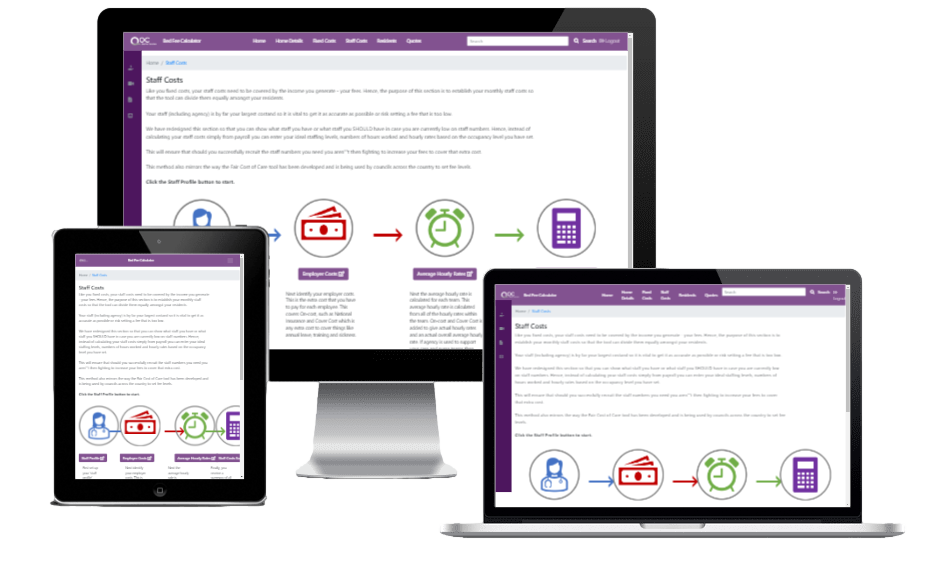There are two words – just two – that are possibly the most powerful words in our language. They are not sexy or romantic (that would be 3 words), they aren’t long, difficult to pronounce, multi-syllabic words. They aren’t poetic, possess no beautiful lilt or rhythm. They are every day, mono-syllabic, dull words.
But together – they are so powerful. They form a question that we all subliminally ask in our daily lives, but few actively ask with a view to consciously process and make things better.
Successful business leaders and managers ask this question all of the time to make their businesses successful. You should be asking this question in your care home.
And talking of time – actively asking this question will make a time traveller of you.
If you are in any position of responsibility from world leader to business owner to manager, you should always be asking ‘WHAT IF…?’.
When you ask ‘what if…?’ you are instantly propelled from the reactive present to the strategic future. You instantly cross the divide from the decision you are contemplating to the possible outcomes of that decision. You can see the potential consequences of taking the action the question is asking, or the consequences of not.
It is a powerful tool to have in your armoury and one you should use whenever faced with a problem, challenge, or decision to make.
Our subconscious asks this question all the time. It’s the angel on our shoulder that hopefully guides us down the right path towards the desired solution.
When growing up, some ask it too much and become too afraid to act, others not enough and suffer life-changing consequences. It’s a question that can have a profound impact on our actions – some good, some not so.
What If…
• She says ‘no’?
• I’m not good enough?
• Land badly?
• We don’t use contraception?
• I choose the wrong subjects?
• I don’t say anything? What if I do?
• I turn left?
As grown-ups in positions of responsibility, you should be asking this question regularly and often. Ask the question, review the possible outcomes and, as far as possible, plan for the worst.
By all means, hope for the best but don’t base any strategic decisions on that hope. Plan for the worst and at least if the worst happens, you’re ready (or as ready as you can be) and if it doesn’t turn out that bad – you are laughing.
If, as a leader, you want your care home to be successful and the best it can be – ‘what if…?’ is a question that you and your management team should be consciously asking – and then actively seeking the answers to it.
In these unprecedented times, all of us need to ask this question. There has never been a time when asking ‘what if?’ questions is so important to help you make the right strategic decisions to ensure your care home is around in the years to come.
So, what should you be asking? Well, of course, that’s down to you and your particular challenges, regardless of Covid. Asking ‘what if…?’ is a powerful way to address all types of challenges.
‘What if we have a safeguarding incident?’ ‘What if one of our residents or staff members has a positive Covid-19 result?’ ‘What if my deputy manager resigns?’ ‘What if I fall ill?’ ‘What if CQC turns up to inspect tomorrow?’ ‘What if the lift breaks down?’ ‘What if we don’t fill our empty beds in the next few weeks?’
When you ask specific questions, your brain can’t help but to envisage the scenario – you are propelled into that possible future and have to visualise the impact of this situation occurring. Any situations that make you uncomfortable, that you don’t have an answer for, or that you think would have a detrimental impact on your business, need to be addressed and solutions found.
For example, you might understandably think your care home needs you and so you can’t afford to fall ill. But what if you do? What will happen? How do you mitigate for this risk and eliminate its impact or reduce it as far as possible?
Then there are bigger challenges such as, ‘What if Coronavirus continues through to the end of next year and beyond?’ ‘What if I end up with too many empty beds for too long?’ and ‘What if my costs have become greater than the fees I’m receiving?’
You should think through and address these kinds of questions because the potential impact of these scenarios could harm your care home to the extent of causing it to fail.
All challenges, risks and threats, that lie within your sphere of control (so not meteorite impacts and earthquakes) like the ones above, must be and can be addressed. They all have solutions. Let’s look at one.
What if Coronavirus continues through to the end of next year and beyond?
Definitely one all care providers should be asking and exploring. Even though this week the first Covid vaccine, that offers 90% protection, was announced, you still need to ask, ‘what if…?’.
What if it doesn’t work? What if we can’t get it? What if people refuse to take it as it’s been developed so quickly that long-term side effects could still be an unknown?
Always plan for the worst. And so, I would plan for there to be no end in sight. I would plan for a tough winter and for this virus to never fully go disappear (like the flu virus) and for re-occurring lockdowns.
Based on that worst-case scenario, what do you strategically need to do in order for your care home to not just survive but to adapt and manage this situation? What do you need to consider when planning how to manage this virus? What additional questions does this big ‘What if…?’ question raise?
PPE, testing staff weekly and residents monthly, checking residents daily have increased my weekly costs dramatically. How do I ensure that we can manage these extra costs, possibly through next year and beyond? First, I would work out exactly how much all these extra tasks, that my carers and nurses need to carry out, is costing me on a weekly basis. Then there are other extra tasks such as the extra cleaning and sanitising your cleaners need to carry out and so on, plus of course your PPE cost.
If you haven’t already worked out this extra cost, then it’s urgent that you do so that you know how much this is costing you. I’ve worked out it could easily be costing you the equivalent of 3 weekly bed fees or more every week. I outline all of your costs in a ‘Cost of Coronavirus’ report, if you haven’t seen it, click here to download it.
All this extra effort takes time. What is the impact on their other daily duties? As you ask more questions you will open up other issues you may not have previously seen. In this ‘Cost of Coronavirus’ report I highlight the time impact of these tasks too. If you don’t address the time impact too then things won’t get done, such as keeping care plans up to date or taking mandatory training sessions and your compliance may not be where it needs to be.
Relatives need to be able to see their loved ones. How do I ensure they can visit safely once more? Do you need to change the layout of your care home? Do you need to buy outdoor pods or sheds? How much will this cost?
I have more empty beds because of Covid-19. We will be running our care home at a loss if we lose any more clients. What do I do?
If you’ve read my other posts or reports, you’ll know I’m all about the numbers. You run a business – you need to know your numbers. Oh and if you do have empty beds then you really should read this article, If Your care Home has Empty Beds You Need to Read This before filling them.
Based on your average fee level, what occupancy level threshold would tip you over into the red – so you’re not even covering your running costs? Of course, to know this you must know your weekly running (fixed and staff) costs.
If you don’t produce monthly or quarterly financial data, then use your last annual accounts. Bear in mind that you will need to add the extra cost that this pandemic has burdened you with and which won’t show in your accounts. Download my ‘Cost of Coronavirus’ report that I mentioned above, to help you.
Once you have accurately calculated your running costs, take your average bed fee – how many residents on this fee do you need in order to cover these costs?
For many, this cost-covering occupancy threshold might be too high. (This is why it’s so important that you know this.) Let’s say you run a 50-bedded care home and have worked out that your occupancy threshold is 95%. 95% of 50 is 47.5. That means 3 empty beds will tip you over the threshold and you start to lose money.
95% is clearly an unhealthy threshold and it makes your care home financially vulnerable. The clear solution is to lower this threshold. The lower this threshold, the financially stronger – more resilient – your care home will be. What is your threshold and where does it need to be?
Say you set a goal to lower this threshold to 80%. If you could do that then you could have up to 10 empty beds out of the 50 and still cover your costs. This would make your care home far more resilient to the financial challenges it faces.
When facing particularly tough challenges, the knee-jerk reaction is to say, ‘we can’t do that’ and to ignore it and hope it will go away.
Reducing this threshold to 80% might well be an unachievable goal, but how do you know?
A successful leader would say, ‘that’s tough target but let’s see what it would take to do that.’ Maybe an achievable target is to reduce the occupancy threshold to 85%. In this case, instead of 3 empty beds tipping you over, it’ll take 8 empty beds. Maybe you first aim for 90%, then 85% and finally push to 80% – that’s your call.
How to actually lower your occupancy threshold is beyond the theme of this post, but very quickly…it has to start by, again, knowing your numbers. Look at each resident fee and check that it is right.
Compare the care that the person needs and is receiving against the care he or she needed and received when the fee was last set. If that care has changed, then calculate the cost of the care they are currently receiving at current hourly rates – which may have increased because the national living wage has increased – what your new fee should be and then arrange a review meeting with your referrer and negotiate your new fee level.
As well as the increased cost of delivering care, your running costs, such as utilities, food and not least because of coronavirus – will have increased and so this is your opportunity to calculate a new fee based on these current running costs.
We review our care plans and fees quarterly and you should too in order to be absolutely certain that your fees reflect the care you are delivering. Check this article if you want to read more on setting the right fees.
If your fees are too low, then by receiving the fees you should, you will immediately lower this occupancy threshold and crucially, increase the financial resilience of your care home.
There are other things you can do to lower this threshold further, but this is the obvious biggie.
By-the-way, please don’t dismiss this idea that your fees might be too low. Too many care homes have closed in the last decade because they ran out of money, because their fees were too low. So, please do this check and make sure you are not paying for care that your current fee doesn’t cover.
As you see, asking ‘what if…?’ is incredibly powerful and incredibly important. It works at all levels of your care home business from helping you make it run better to ensuring its long-term survival.
There will always be challenges you can’t foresee, like this pandemic. But the stronger your care home is and the better you are at being able to strategically mitigate for potential risks and threats, the better placed you are to manage the unforeseen.
The success of your care home is fully dependent on you setting and receiving the right fees. To quickly check if the fees you are receiving are right use The Care Fee Calculator.
Using this tool, you can enter your running costs once and then in minutes create ‘quotes’ for each of your residents based on the care they need. Then you can add your target profit to get to the fee you should be receiving. This is the quickest way to compare the fee you receive to the fee you need.
AND YOU CAN DO THIS FOR FREE. Take advantage of the 30-day free trial, check if you are receiving the right fees and use the tool to help you negotiate a better fee if you aren’t.









